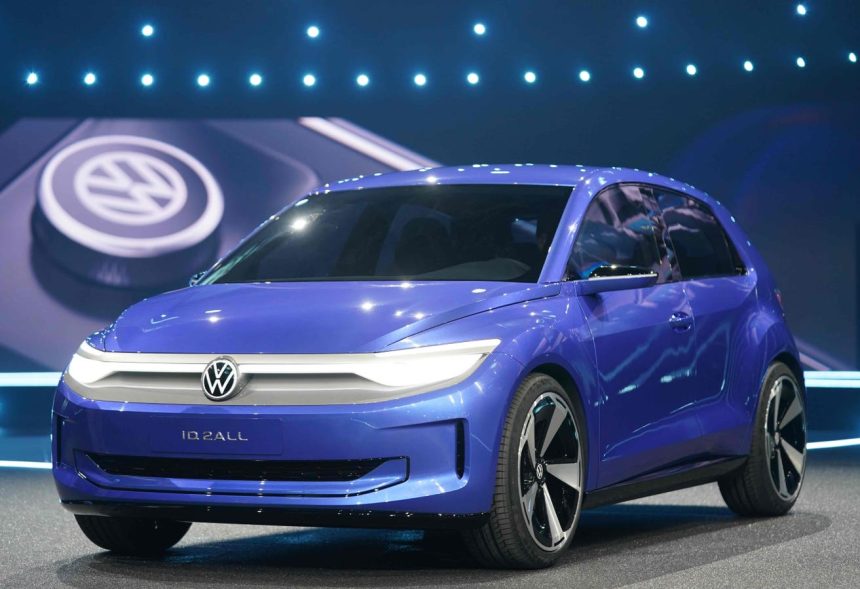S&P Global said the growth in electric vehicle sales in Europe (and North America) is slowing while research group ICCT reckons EV sales will “further accelerate” over coming years.
The powerful growth of EV sales has stalled over the last six to nine months, according to most forecasters, as the first bout of buying by early adopters and corporate incentives plateaued.
In Europe, sales of about 2 million EVs a year have paused. Schmidt Automotive Research said during the opening third of 2024 Western Europe EV market share stalled at 14.4% compared with the same period last year.
Given that a consensus of expert forecasters says sales will explode between now and 2030 to around nine million a year, automakers are relying on new, cheap, mass-market vehicles to propel that growth. There is no sign of any such vehicle in Europe yet, although they do exist in China.
Automaker shareholders are nervously awaiting developments. In Europe, failure to meet government-mandated EV sales quotas means bankruptcy-threatening penalties.
S&P Global, in a report, said the transition to electric vehicles is fading, although China’s momentum continues. The change may take longer than once thought.
“In contrast (to China), growth has slowed in Europe and North America amid higher prices and concerns about range anxiety and charging infrastructure,” S&P Global said.
Washington, DC-based ICCT – the International Council on Clean Transportation – said the transition continues to accelerate.
“Ambitious technology-forcing regulations adopted by the European Union, U.S., Canada and the U.K. in 2023 and early 2024 are expected to further accelerate the ZEV transition over the coming years,” ICCT said in its annual assessment of automakers’ progress transitioning to zero-emission vehicles.
The ICCT is a think tank funded by groups which include the William and Flora Hewlett Foundation, and the David and Lucile Packard Foundation, according to its website.
The ICCT report said Tesla and BYD of China continue to lead global automakers in the transition to zero-emissions vehicles.
“Mercedes-Benz, SAIC, and Chang’an were the most improved manufacturers in the rating compared with 2022. Automakers based in Japan and India are still at the bottom of our ratings, but Tata Motors and Suzuki have shown progress,” the report said.
Tata Motors owns JLR. SAIC, formerly Shanghai Automotive Industry Corp, is a Chinese state-owned manufacturer. Its MG brand EVs are big sellers in Europe. China’s Chang’an Automobile Co is also state-owned.
S&P said in its report China continues to lead the West in the adoption of EVs, and its vehicles are close to price parity with internal combustion engine vehicles. EV penetration is contracting in every major region.
“We have lowered our electrification outlook during the past 12 months, reducing our 2030 global battery EV market penetration outlook by 2.3 percentage points during that time. Most legacy automakers are affected by diluted profitability from the sale of EVs, and a more protracted electrification process is an opportunity for them,” the report said.
The debate about the future of battery technology is still unresolved. Most experts reckon by 2030, solid-state batteries will begin to take-over, offering lower prices and weight, and improved range.
Private buyers in Europe, and the U.S., are holding off because of many worrying doubts about the viability of EVs.
“Apart from the relative expense, customer hesitation to purchase battery EVs in Europe and North America is compounded by concerns over range and charging infrastructure, as well as residual values and the risk of rapid technological obsolescence,” said Demian Flowers, head of financial markets at S&P Global Mobility.
The report said buyers are reluctant to switch to EVs in Europe because of cost. The average premium on an EV compared with an ICE vehicle is 24%. Reducing government subsidies have also weakened the case. The average price of an EV in Europe is $52,300 versus $42,100 for an ICE.
The roll-out of cheaper EVs remains slow.
“We expect entry-price EVs in the €20,000-€25,000 range – the VW ID.2 and Renault Twingo to arrive no earlier than 2025-2026 and only for a small subset of the portfolios. To make these vehicles truly affordable, product costs need to decrease materially – most notably, the cost of battery packs, which, on average, represent 40% of an electric vehicle’s price,” the report said.
BYD of China has said it will sell its little Seagull in Europe for under €20,000. It hasn’t confirmed a launch date yet, but sales are expected to start next year, always assuming new tariffs on China imports by the EU don’t torpedo the business.
Meanwhile, Volkswagen’s competitor in this sector, the ID.1, isn’t expected until 2027. Renault and Stellantis are ahead of VW in this niche, but not by much.
The slowdown of EV growth will benefit the established manufacturers, the report said, because it gives them more time to prepare for the transition and extend the profitability of ICE models.
But this won’t please EU regulators who seem determined to enforce the rules, despite the help this offers China and its 30% advantage in efficiency. The EU is determined to end the sales of all new ICE vehicles by 2035.
Read the full article here
















